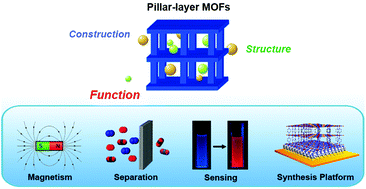The construction, structures, and functions of pillared layer metal–organic frameworks
Abstract
Pillared layer metal–organic frameworks (PL-MOFs), belonging to one representative of porous materials, have witnessed major advances in the past few years. They can be classified into subsets – 3D pillared layers, 2D pillared bilayers, and interpenetrated and interdigitated layers. By choosing the molecular structures and chemical properties of the modular organic ligands used in PL-MOFs, high porosity and large internal surface areas can be achieved, while the shape, size, and surface of the channels can be modified to enhance their physical properties. The structural flexibility and response to different guests and external physical stimuli render PL-MOFs good candidates for investigating solid state structural transformations and reactions. In this review, we explore how modular ligand design leads to various PL-MOFs. The importance of PL-MOFs will be highlighted by their special functions including magnetism, sorption, separation, sensing, catalysis etc. We will also introduce recent findings on PL-MOFs in dynamic structural transformations, step-by-step assembly, and preparation of hybridized MOFs and nano-films.
Our collaborative work started in earnest after our meeting at ICMM2010 in Beijing. The complementarity of the interests of our two groups led to a successful development of the chemistry and physics of metal–organic frameworks and clusters, involving the design, elaboration, characterization and studies of the structural and physical properties of the novel materials. In particular, studies were directed at multi-functionalities such as structural properties, electrical conductivity, magnetism and in some cases optical properties. In the six years of this collaborative work, funded by the Guangxi Province (China) and the CNRS (France), 22 papers have been published, several in high-impact factor journals and citations exceeding 700. As well as excelling on the international level, the groundwork has been the development of students. The present review is a collection of materials with one common interest in the area concerned with layered structures and their properties and presented in the context of what are present-day studies internationally.

- This article is part of the themed collections: 2016 Inorganic Chemistry Frontiers Review-type Articles and Sino-European Collaborators

 Please wait while we load your content...
Please wait while we load your content...